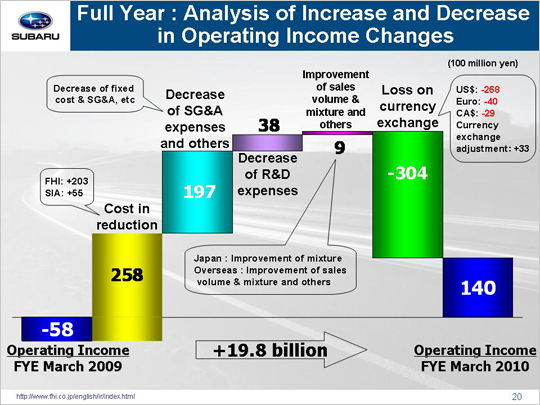
| Now let's look at the factors behind the year on year change in operating income for this fiscal year period, in which we will go from an operating loss of 5.8 billion yen to an operating income of 14.0 billion yen. We will gain 25.8 billion yen due to a reduction in material costs, saving 20.3 billion yen at FHI and 5.5 billion yen at SIA. While FHI will gain 9.1 billion yen as a result of cutting material costs and another 11.2 billion yen after recouping its losses from the previous fiscal year's materials price hike. SIA will gain $40M from a reduction in material costs and another $12M after recouping its losses from the previous fiscal year's materials price hike. A gain of 19.7 billion yen will be generated as a result of lower SG&A and other expenses. This gain can be broken down into four parts: (1) A gain of 1.4 billion yen in fixed costs will come from a loss of 1.4 billion yen at FHI and a gain of 2.8 billion yen at SIA. FHI will see a gain of 1.8 billion yen due to decreased fixed processing costs and a loss of 3.2 billion yen due to an increase in expenses for suppliers' dies. SIA will get a gain of $27M, which includes a gain of $36M due to reduced expenses for suppliers' dies and a loss of $9M coming from increased processing costs and other expenses. (2) A decrease in SG&A expenses will be resulted in a gain of 20.6 billion yen. FHI will reduce advertising and SG&A expenses, leading to a gain of 6.7 billion yen. Domestic dealers will generate a gain of 7.3 billion yen as our SG&A cost reduction efforts through consolidation of distributors. Despite a $22M advertising cost and $12M SG&A expenses increase, SOA will see a gain of 1.5 billion yen ($14M) thanks to a reduction of per-unit incentive dropped $500, down from $1,600 for January to December 2008 to $1,100 for April 2009 to March 2010, resulting in a gain of $48M. While our Canadian subsidiary generated a loss of 1.3 billion yen, our other subsidiaries realized a gain of 3.8 billion yen due to ongoing cost reduction efforts. (3)An increase in costs associated with warranty claims will lead to a loss of 2.8 billion yen. We had made an allowance for costs associated with warranty claims in overseas markets during the first half of the fiscal year. (4)Others will be 0.5 billion yen. We will gain 3.8 billion yen due to a reduction in R&D costs (down from 42.8 billion yen to 39.0 billion yen). This explains the temporary lull in new model development and our ongoing efforts toward increasing R&D efficiency. The factors that will lead to the increase in operating income included a gain of 0.9 billion yen due to an improvement of sales volume and mix. This gain can be broken down into three areas: (1) The domestic market will see a gain of 5.6 billion yen thanks to the effect of the new Legacy. (2) We will see a gain of 10.8 billion yen in overseas markets due to increased sales in NorthAmerica. (3) We anticipate a loss of 15.5 billion yen resulting from inventory adjustments, etc. Operating income will be diminished by a 30.4 billion yen loss due to exchange rate fluctuations. This will include a loss of 26.8 billion yen due to an approximate 9 yen appreciation against the U.S. dollar, a loss of 4.0 billion yen due to an approximate 15 yen appreciation against the euro, and a loss of 2.9 billion yen due to an approximate 7 yen appreciation against the Canadian dollar. These factors combined brought operating income up 19.8 billion yen for a total of 14.0 billion yen. |